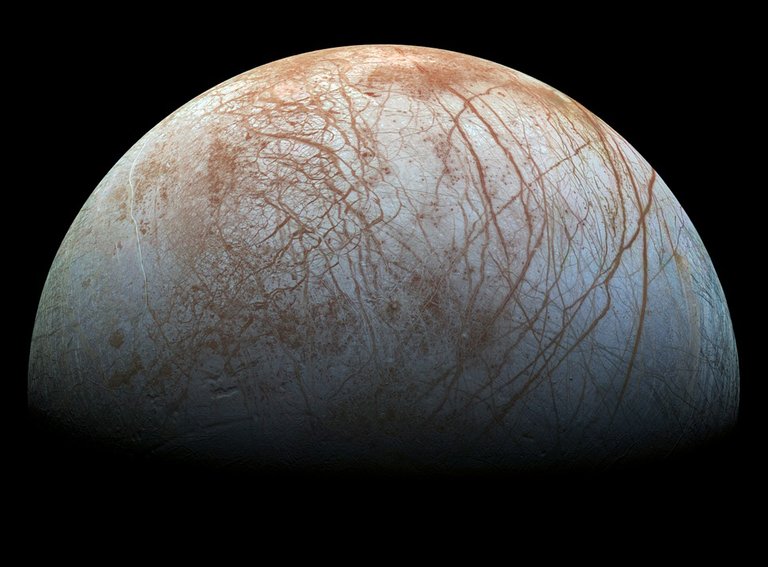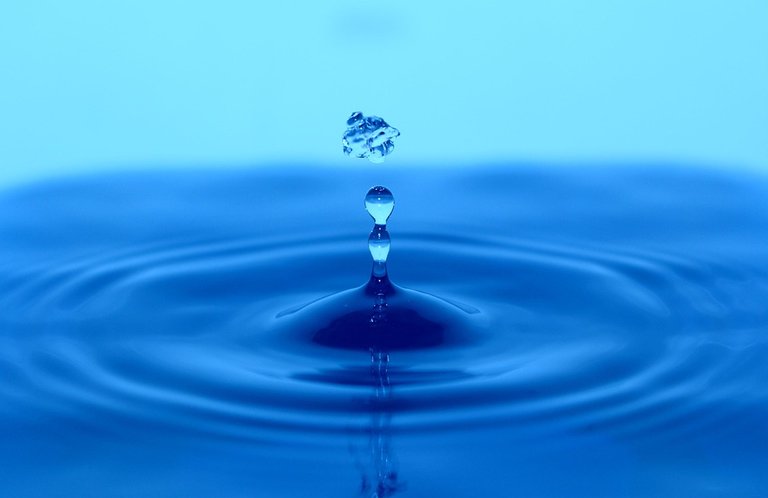
Europa Is a satellite of the giant gas planet Jupiter. Europa was discovered in 1610 by Galileo Galilei (with an argument from Simon Marius, who claimed he had found it in 1609). The satellite is named in the name of a Phenicia noble lady named Europa, who was later married by Zeus and became queen of Crete. This satellite is the smallest satellite of the four Galilean satellites.
The satellite is made of silicate rock and is thought to have an iron core. Europa has an atmosphere consisting of oxygen. Its surface consists of ice and is considered the flattest in the entire Solar System. Youth and flatness from the surface of Europa have led some scientists to speculate about the existence of the ocean below it, which can save lives.
Is there really life, even at a cell level, in Europa?
Until now there has been no other life exists in Europa. But it is true there is water on the Jupiter satellite.
Water. Components of this one is indeed a preliminary requirement for a planet to be categorized planets that have the potential habitable. To find such a planet, what is sought is water in the form of liquid instead of gas or ice. In a star, a potentially habitable planet can be searched in a habitable area of a star. Just like Earth.
In the Solar System, a planet that has life is only in Earth's. The search is also done on other planets like Venus and Mars. Venus is too hot for life. The greenhouse effect continues to be the planet's biggest problem. Mars, the red planet is thought to have water in the past. Not now.
The farther from the Sun, the lower the temperature. This means that water cannot survive in the form of liquid. In this area, there are giant gas and ice planets that dominate. The water here certainly has no liquid form. Water is already ice. That's the planet. Moreover, the satellite surrounding it.
Europa, the satellite of the giant gas planet Jupiter.
The surface of this satellite is seamless. Not many craters and surfaces are highly reflective or have the ability to reflect high. Of course, the surface is covered by a thick layer of ice. As expected. Water in this area certainly frozen to be ice. Sunshine received fewer and fewer.
Since the 1970s there have been several missions that fly cross: Pioneers 10 and 11 and Voyager 1 and 2. From 1995 to 2003, it was the Galileo's rides turn to do a long-term mission on this Jupiter satellite and send information about Europa to the scientists on Earth.
Existing data shows a young Europa surface. Smooth, not many craters. Strange? Of course.
Water at Europa
Since the early days of the formation of the Solar System, collisions occurring on the surface of planets and satellites have taken place over and over. The crater that adorns the face of a planet becomes a marker of the history of a planet's journey. Just look at the face of the Mercury and the Moon full of craters. Mars too. Earth also has many craters. However, erosion and tectonic movements on Earth are the facial rejuvenation factor of the Earth.
No crater means there is another process that takes place in Europa that can renew ice from time to time so that the satellite surface is always young.
Galileo's observations show signs that lead to tectonic processes in Europa. Galileo showed a tectonic plate of icebergs or large ice plates covering the surface of the satellite. This ice slab also has a crack with a dark pattern along the crack and there is a reddish orange ice chunk.
The iceberg in Europa is also not static. This means that there is a shift of plate and collision between the ice plates that occur just like on Earth. This process is thought to erase the crater footprint in Europa. If there is a shift of the plate, then there is an indication of the presence of water. Chances are, Europa has water beneath the surface.
Other indications come from the observation of the Hubble Telescope that sees the existence of plums or bursts of geysers that appear on the surface of Europa. The presence of geysers in Europa is a strong indication of the presence of water beneath the surface of the satellite. The burst of geysers that appear similar to the lava bursts that appear during volcanic eruptions on Earth. The difference, in Europa, is not the lava that was sprayed but the water. This means that in Europe there is Cryovolcano or volcano spraying water, ammonia, and methane as a substitute for lava. In Europa, it seems that the spray of water and ice.
Europa is far from the Sun, and there should be no water on this satellite. That is, there are other mechanisms that warm the Europa and cause water to remain in the liquid form. Possibilities other than a little sunlight are internal mechanisms.
After an investigation, apparently the warming in Europa occurs as a result of not flexing or we call it tidal flexibility.
Tidal flexing occurs because of the interactions between Europa, Ganymede, Io, and Jupiter. Europa takes 3.5 days to circle Jupiter. Each one orbits Jupiter, Io who is in orbit closer to Jupiter has completed 2 laps around the giant gas planet. In the outermost orbit, there is Ganymede which once completed one round on Jupiter, maa Europa has completed 2 orbits around Jupiter and Io completed its 4th orbit.
Without the existence of other satellites, Jupiter and Europa interactions will tend to make Europa's orbit a circle. But, Europa's orbital resonance with other nearby Jupiter satellites (Ganymede and Io) causes these satellites to move around Jupiter at different speeds, approaching and away from Jupiter because orbit that is not completely circular.
When near Jupiter, the greater tensile force causes bulges or tidal bulges to be larger. Similarly, vice versa when away from Jupiter. The force of gravity is smaller, and the bulge becomes smaller. This motion is similar to squeezing and stretching the rubber ball. As a result, there is a tidal friction that appears on the inside of Europa which then warms up the inside of this satellite.
The heat generated from this tidal friction is enough to make ice in Europa move and have enough energy to erase the crater traces.
Apparently, the heat generated is also sufficient to keep the water beneath the surface of Europa remains liquid and eventually bursts outward as a burst of geysers on the surface.
Allegedly, the water in Europa has a depth of up to 100 km or much deeper than the deepest sea on Earth. There is a water reservoir beneath the surface of Europa or we call it a global ocean locked beneath the surface of Europa. In fact, when compared to Earth, the amount of water in Europa is much greater. But Europa's distant location from the Sun caused the global ocean surface at Europa to freeze. It is estimated that the ice crust or ice sheet covering the Europa surface has a thickness of 15-25 kilometers.
Life in Europa
Europa has water. What about life?
Water is an essential component of life on Earth. But water is not the only component that determines the growth of life on a planet or satellite. There are other chemical compounds needed for life to thrive.
Is the ocean in Europa as salty as it is on Earth? Are there minerals? Are there any other chemical compounds mixed in Europa's global ocean? Or pure H2O?
Observations show that reddish-orange ice is an indication that the oceans at Europa do contain salt. In very cold conditions such as in Europe and the surface of the ice bombarded by the sunlight particles, it will be red. Salt is thought to originate from the ocean floor of Europa. If so, it can be concluded that Europa's ocean floor contains minerals that rise and reach the surface.
It may seem strange that on the seafloor of Europa, there is no sunlight that can be a source of energy for any form of life that may be formed. However, if Europa's seafloor has hydrothermal vents as found on the ocean floor on Earth, then there is still a possibility for life to grow.
However, until now, hydrothermal vents in Europa have not been known to exist because the core of the Europa is not hot enough to produce liquid rock.
But, if there is any ... then the interaction between rocks and water on Europa's seabed could produce cracks in the core crust which then release minerals into the oceans. The reaction between minerals and salt in Europa's oceans could lead to the evolution of life. On the other hand, oxygen can be produced by ice on the surface of Europa. The intense radiation from Jupiter will break the water molecules into hydrogen and oxygen. In the end, oxygen will react with other chemical compounds in the ocean and can lead to the formation of life.
There is various possibilities life can form in Europa. But, until now there has not been any life form found in Europa.
All we know is that there is only a salty global ocean just like on Earth.
Reference :
- https://en.wikipedia.org/wiki/Europa_(moon)
- https://www.independent.co.uk/news/science/europa-jupiter-alien-proof-tectonic-plate-movement-activity-heat-life-latest-planet-a8095116.html
- https://www.popsci.com/nasa-europa-lander-alien-life
- http://abyss.uoregon.edu/~js/ast121/lectures/lec13.html
- https://geology.com/stories/13/life-on-europa/




Oman bereh that..raseuki.. Nyan payah kapeurno
Nyan robott sit........ :)
For years it was believed that Earth was the only planet in our solar system with liquid water. More recently, NASA revealed its strongest evidence yet that there is intermittent running water on Mars, too!
This may the second earth for us....
CheersNice one @alf4t1h
hopefully
:)thanks @vinamra
Hello @alf41h, not only Europa but Ganymede and Enceladus appear to have the ocean's beneath their icecap. Let's hope we find some form of life down in one of those oceans. Btw. you post quite a few astronomy articles, which is great to see!
yes, it seems so. hopefully, someday there be places that can be occupied out there
thanks @terrylovejoy
Peace, Abundance, and Liberty Network (PALnet) Discord Channel. It's a completely public and open space to all members of the Steemit community who voluntarily choose to be there.Congratulations! This post has been upvoted from the communal account, @minnowsupport, by alf4t1h from the Minnow Support Project. It's a witness project run by aggroed, ausbitbank, teamsteem, theprophet0, someguy123, neoxian, followbtcnews, and netuoso. The goal is to help Steemit grow by supporting Minnows. Please find us at the
If you would like to delegate to the Minnow Support Project you can do so by clicking on the following links: 50SP, 100SP, 250SP, 500SP, 1000SP, 5000SP.
Be sure to leave at least 50SP undelegated on your account.